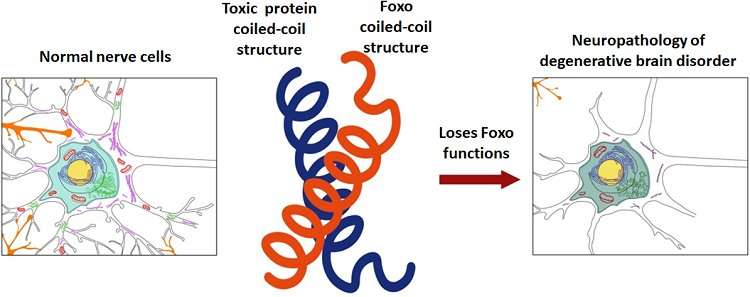A new hope in treating neurodegenerative disease

A research team led by Professor Sung Bae Lee of Brain and Cognitive Sciences and Professor Daehee Hwang of New Biology (vice-head of the Plant Age and Life Research Group, IBS) has identified the early neuropathological mechanism of structural characteristics of polyglutamine toxic protein on neurodegenerative brain disorders. The research was conducted with Professor Yuh Nung Jan at the Howard Hughes Medical Institute (HHMI) in the U.S.
The number of patients with neurodegenerative disorders is growing rapidly as human life expectancy increases. Although many scholars are researching the pathogenesis and the advancement of neurodegenerative brain disorders, not much has been identified yet. And developing an actual treatment is challenging since it is difficult to diagnose the disease early.
In this study, the researchers described the coiled-coil structure of polyglutamine toxic protein, which is like an entangled telephone wire, and causes the rapid deformation of neuron and early neurodegenerative diseases such as Huntington's and spinocerebellar ataxias.
Proteins abnormally combine to form the coiled-coil structure of polyglutamine toxic protein. The research team discovered that its structure inside neurons causes early neuropathy by combining with the transcription factor FOXO protein, which affects the formation of dendrites.
While the research focused on FOXO as the first factor of the early symptoms of neurodegenerative brain disorders, it also predicted that other factors would exist. The research team thus expects to conduct related studies by focusing on clarifying additional factors based on this research.
Professor Lee said, "The core of this research is that the coiled-coil structure of the toxin protein that causes degenerative brain disorders entangles with the coiled-coil structure of the other protein, which is an important cause of early neurodegenerative diseases. By developing a treatment targeting the entanglement based on the coiled-coil structure through this research, we expect to be able to have effective treatments to alleviate the early symptoms of neurodegenerative brain disorders."
This study is published in the November 6th issue of Proceedings of the National Academy of Sciences.
More information: Min Jee Kwon et al, Coiled-coil structure-dependent interactions between polyQ proteins and Foxo lead to dendrite pathology and behavioral defects, Proceedings of the National Academy of Sciences (2018). DOI: 10.1073/pnas.1807206115



















